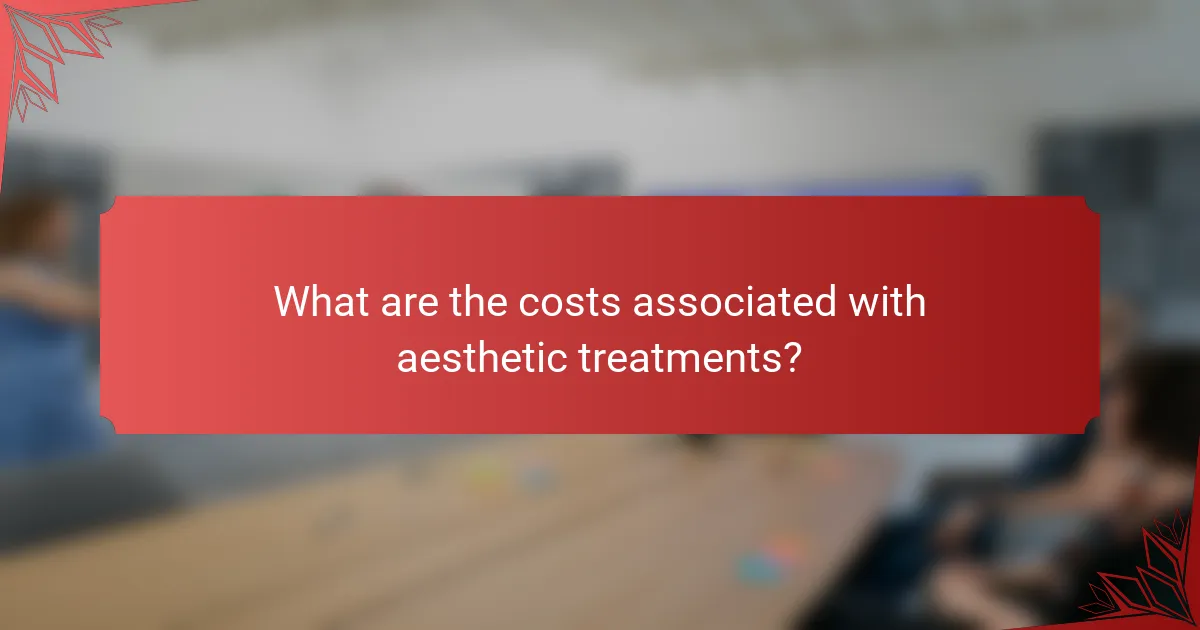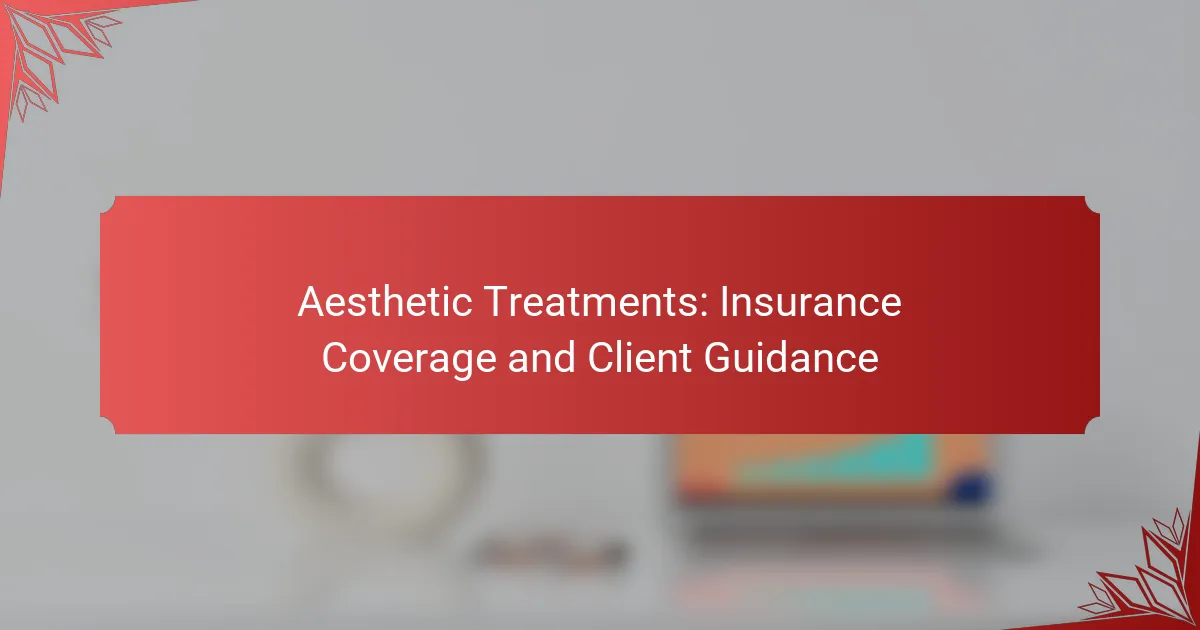Aesthetic treatments can sometimes be covered by insurance in South Africa, particularly when they are considered medically necessary. To understand your coverage options, it’s essential to consult your insurance provider and review your policy, as coverage can differ significantly based on the treatment and individual plans. Be aware that many insurers exclude procedures deemed purely cosmetic or experimental, emphasizing the importance of medical justification for treatment approval.

What aesthetic treatments are covered by insurance in South Africa?
In South Africa, certain aesthetic treatments may be covered by insurance if they are deemed medically necessary. Coverage often depends on the specific health condition being treated and the policies of individual insurance providers.
Botox for medical purposes
Botox is primarily known for its cosmetic applications, but it is also used to treat various medical conditions, such as chronic migraines and excessive sweating. When prescribed by a healthcare professional, these treatments may be eligible for insurance coverage.
Patients should provide documentation from their doctor detailing the medical necessity of the Botox treatment. This can help in securing approval from the insurance provider.
Dermal fillers for reconstructive reasons
Dermal fillers are typically used for cosmetic enhancements; however, they can also serve reconstructive purposes, such as restoring volume after trauma or surgery. Insurance may cover these treatments if they are justified as necessary for health or functional reasons.
Consulting with a qualified medical professional who can outline the reconstructive need is crucial for obtaining insurance approval. Always check with your insurer regarding specific coverage policies related to dermal fillers.
Laser treatments for skin conditions
Laser treatments can address various skin conditions, including acne scars, psoriasis, and other dermatological issues. If these treatments are performed to alleviate a medical condition rather than for cosmetic enhancement, they may be covered by insurance.
It is essential to have a thorough evaluation by a dermatologist who can recommend laser treatment as a necessary intervention. Documentation of the condition and treatment plan will be required for insurance claims.
Facial surgeries for health-related issues
Facial surgeries, such as rhinoplasty or facelifts, are often performed for aesthetic reasons but can also be necessary for health-related issues, like breathing difficulties or trauma recovery. In such cases, insurance may cover the costs if the surgery is deemed medically necessary.
Patients should ensure that their surgeon provides a clear explanation of the health-related reasons for the surgery, along with any required medical records, to facilitate the insurance claim process.

How to determine if your aesthetic treatment is covered?
To determine if your aesthetic treatment is covered, start by checking with your insurance provider and reviewing your policy details. Coverage can vary widely based on the treatment type, the provider, and your specific insurance plan.
Consult with your insurance provider
Contact your insurance provider directly to inquire about coverage for your specific aesthetic treatment. Be prepared to provide details about the procedure, including its medical necessity, as some treatments may only be covered if deemed essential for health reasons.
Ask about any pre-authorization requirements and whether a referral from a primary care physician is needed. This step is crucial, as failing to obtain necessary approvals can lead to unexpected out-of-pocket expenses.
Review your policy details
Thoroughly review your insurance policy to understand the coverage limits and exclusions related to aesthetic treatments. Look for sections that specify what types of procedures are covered, any applicable deductibles, and co-payment amounts.
Pay attention to terms like “cosmetic” versus “reconstructive,” as many policies differentiate between the two. If you find the language confusing, consider requesting clarification from your insurance representative to avoid misunderstandings later.

What are the common exclusions in aesthetic treatment insurance?
Common exclusions in aesthetic treatment insurance typically include procedures deemed cosmetic rather than medically necessary. Insurers often do not cover treatments that lack FDA approval, are classified as experimental, or are performed solely for aesthetic enhancement without a medical basis.
Cosmetic procedures without medical necessity
Insurance plans usually exclude cosmetic procedures that are not deemed medically necessary. Treatments like facelifts, breast augmentations, and liposuction fall into this category if they are performed for aesthetic reasons alone. Clients should verify with their insurance provider whether a procedure has a medical justification to avoid unexpected costs.
To illustrate, if a patient undergoes a rhinoplasty solely for cosmetic improvement, it is unlikely to be covered. However, if the procedure corrects a breathing issue, it may qualify for coverage.
Non-FDA approved treatments
Procedures that have not received FDA approval are generally excluded from insurance coverage. This includes treatments that are still undergoing clinical trials or have not been proven safe and effective. Clients should be cautious and research the approval status of any treatment before proceeding.
For example, certain injectables or devices marketed for aesthetic purposes may lack FDA clearance, making insurance reimbursement impossible. Always consult with a qualified provider to ensure the treatment is recognized by regulatory bodies.
Experimental procedures
Experimental procedures are often not covered by insurance due to their unproven effectiveness and safety. These may include new techniques or technologies that have not yet been validated through extensive clinical studies. Patients should inquire about the classification of a procedure before committing to it.
For instance, a new laser treatment for skin rejuvenation that is still in the testing phase may be considered experimental. Patients should weigh the risks and potential costs against the benefits when considering such options.

How to choose an aesthetic treatment provider?
Choosing an aesthetic treatment provider involves assessing their qualifications, reputation, and results. Focus on their credentials, client feedback, and visual evidence of their work to ensure you receive safe and effective treatments.
Check credentials and certifications
Verify that the provider has the necessary licenses and certifications to perform aesthetic treatments. Look for qualifications from recognized institutions and ensure they are up-to-date with current regulations in your area.
In the United States, for example, practitioners should be board-certified in dermatology or plastic surgery. In Europe, check for compliance with local health authorities and relevant professional bodies.
Read client reviews and testimonials
Client reviews and testimonials can provide insights into the provider’s quality of service and patient satisfaction. Look for feedback on platforms like Google, Yelp, or specialized aesthetic treatment forums.
Pay attention to recurring themes in reviews, such as the provider’s communication style, professionalism, and the overall experience. A high number of positive reviews can indicate a reliable choice.
Evaluate before-and-after portfolios
Reviewing before-and-after photos is crucial in assessing the provider’s skill and the effectiveness of their treatments. Look for a diverse range of cases that resemble your own aesthetic goals.
Ensure the photos are authentic and taken under similar lighting conditions. A reputable provider will have a comprehensive portfolio showcasing various procedures and results over time.

What are the costs associated with aesthetic treatments?
The costs of aesthetic treatments can vary widely based on the type of procedure, the provider’s expertise, and the location. Generally, clients should expect to invest a few hundred to several thousand South African Rand for various treatments, with ongoing maintenance often required.
Average costs for Botox in South Africa
In South Africa, the average cost for Botox treatments typically ranges from 1,500 ZAR to 3,500 ZAR per session, depending on the number of units required and the treatment area. Many clinics charge per unit, with prices around 100 ZAR to 150 ZAR per unit.
Clients should consider that results usually last three to six months, necessitating repeat sessions for optimal effects. It’s advisable to consult with a certified practitioner to determine the appropriate dosage for individual needs.
Pricing for laser treatments
Laser treatments can vary significantly in price, with costs generally falling between 2,000 ZAR and 10,000 ZAR per session. Factors influencing the price include the type of laser used, the treatment area, and the specific skin condition being addressed.
For example, laser hair removal tends to be on the lower end of the spectrum, while more complex procedures like laser skin resurfacing may reach the higher end. Clients should inquire about package deals, as many clinics offer discounts for multiple sessions.
Cost comparison of dermal fillers
The cost of dermal fillers in South Africa usually ranges from 2,500 ZAR to 6,000 ZAR per syringe, with the price influenced by the type of filler and the area treated. Hyaluronic acid fillers are among the most popular and can vary in cost based on brand and formulation.
Clients should be aware that results typically last from six months to two years, depending on the filler type. It’s essential to discuss expectations and treatment plans with a qualified practitioner to ensure the best outcomes and avoid unnecessary expenses.

What are the risks of aesthetic treatments?
Aesthetic treatments carry various risks, including potential side effects, complications, and dissatisfaction with results. Understanding these risks is crucial for clients considering procedures such as injectables, laser treatments, or surgical options.
Common risks associated with aesthetic treatments
Common risks include allergic reactions, infection, scarring, and asymmetry. For instance, injectable fillers can lead to bruising or lumps, while laser treatments may cause skin irritation or discoloration. It’s essential to discuss these risks with a qualified practitioner before proceeding.
Factors that influence risks
Several factors can influence the risks associated with aesthetic treatments, including the type of procedure, the skill of the practitioner, and the patient’s individual health profile. For example, patients with certain medical conditions or those who smoke may face higher risks. Always disclose your full medical history to your provider.
How to minimize risks
To minimize risks, choose a licensed and experienced practitioner, and ensure the facility meets safety standards. Research the specific treatment and ask about potential side effects. Additionally, follow pre- and post-treatment care instructions carefully to enhance safety and effectiveness.
